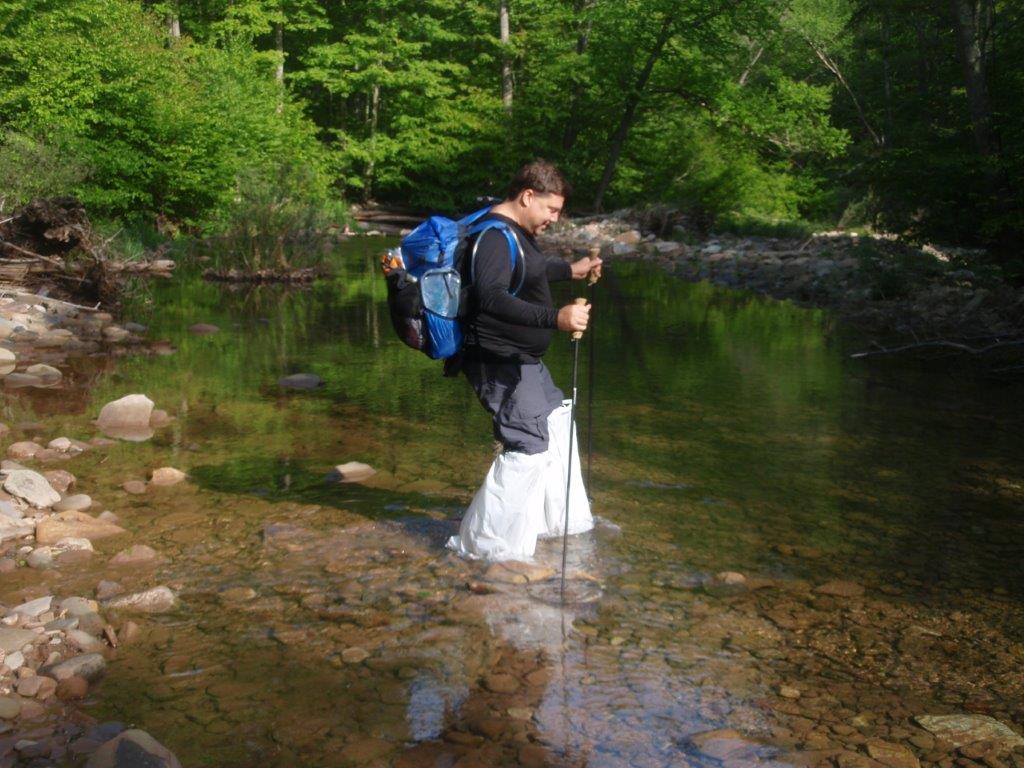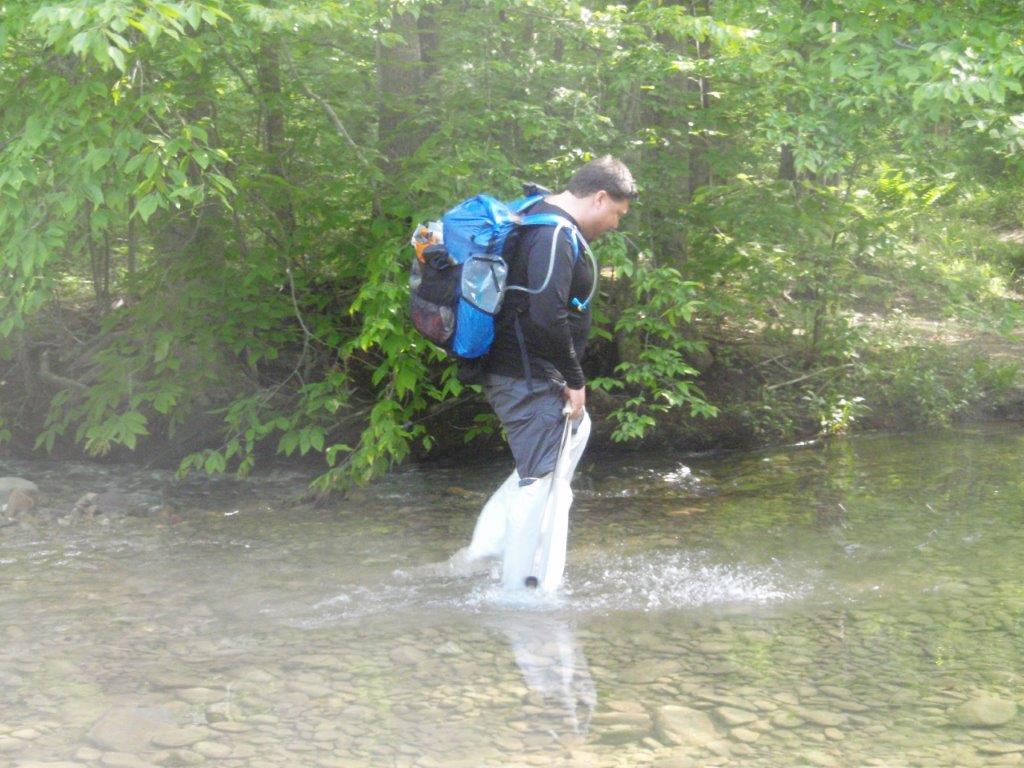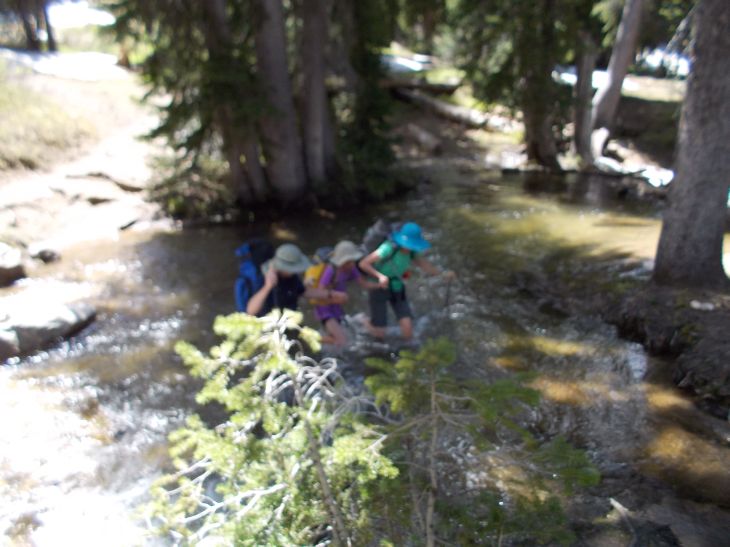Topic
quick stream crossing options
Forum Posting
A Membership is required to post in the forums. Login or become a member to post in the member forums!
Home › Forums › Gear Forums › Gear (General) › quick stream crossing options
- This topic has 31 replies, 18 voices, and was last updated 6 years, 3 months ago by
 Kevin Babione.
Kevin Babione.
-
AuthorPosts
-
Aug 6, 2018 at 12:26 am #3550006
Does anyone here use some strong plastic(or whatever) bags for each foot to quickly pull over a boot or shoe if you prefer to keep your feet dry? yes you can always just walk through, or you can stop and put on your camp shoes, but some fast pull own very light would be handy. Anyone with experience with this? recently in Sequoia Kings I was thinking about this.
Aug 6, 2018 at 1:20 am #3550016Nope
Why do you think have to keep feet dry?
Must have never hiked with wet feet for 5 days straight.
Just wear socks works good . Cushions pointy rocks, adds grip on algae, put dry socks and shoes on after if like.
Aug 6, 2018 at 1:25 am #3550024I think we have all hiked with wet feet and socks many days in a row. For me – I would rather have dry than wet. it is that simple. Trying to avoid the changing socks and shoes thing.
Aug 6, 2018 at 1:28 am #3550027Interesting idea, though plastic bags over shoes might make footing on underwater rocks awfully slippery.
Aug 6, 2018 at 1:42 am #3550029I’ve noticed that when my boots get totally wet, my merino socks develop thin spots. And fungus grows on my feet. I try to avoid.
If I had days of being wet I’d wear low breathable shoes and synthetic socks, then just walk through streams. Feet sort of dry out after a few hours.
Walking barefoot is an option, but I’ve cut my feet before and it takes a while to take shoes off and put back on.
Taking socks off is better, but again, takes time. Inside of shoes/boots still hold a lot of water even without socks, so when I put my socks back on they get wet anyway.
Good idea about plastic bag. I think there’s an old thread about that. It would probably develop holes, but maybe cross quickly before it fills up with water. Yeah, I wonder if the bag would make boots slippery.
Aug 6, 2018 at 2:11 am #3550030There’s the bread-bags-over-your-socks, inside-your-shoes technique. It doesn’t keep your shoes dry, but it keeps your feet drier for a while.
I’ve pondered trash-compactor bags, perhaps trimmed down a bit, as boot condoms for an occasional stream crossing. Just for the crossing and then they come off again, so I think they’d last awhile.
Any stream crossing is easier with trekking poles or going with another person while grabbing each other’s shoulder straps so the two of you become a quadruped.
But mostly I run and jump, or pick my way up and down stream to find a better spot until I come to a stream / river that can’t be jumped, say “screw it”, and then just wade across the rest of the streams that day.
Aug 6, 2018 at 2:40 am #3550033Aug 6, 2018 at 1:12 pm #3550112Ummmm…Regular trash bags definitely DO NOT WORK! Back in ’10 I was on a trail which I knew had a feet-wet stream crossing (the Old Loggers Path in PA). I packed two handle-tie trash bags figuring that they’d last long enough to get me across the one stream…

The stream was not deep or wide, but I had holes in them in seconds and the bags filled with so much water that I had to hold the handles to keep them up:

Needless to say, my feet were soaked as if I had simply walked through the stream without the bags. After that I gave a lot of thought to other options including using trash compactor bags or turkey baking bags. I thought I’d use duct tape in a 1″ strip to make some “laces” that I could tie to hold the bags around my calf. In the end I never tried it – I took a lot of abuse from my buddies on the trip above about my trash bags.
Now I simply get my feet wet and hike. They dry pretty quickly.
Aug 6, 2018 at 6:26 pm #3550168when my boots get totally wet… fungus grows on my feet. I try to avoid
+1, at least in the Pacific NW. In the Sierra, stuff dries out so quickly that wet feet never became an odor issue there, at least for me. Washing the feet at night with soap and water helps with odor, as does using some essential oils on the feet in the morning before hiking (tea tree, Thyme, etc.).
For tough river crossings, you can take your socks off and remove the inserts from your shoes – your shoes will get soaked, but they dry pretty fast if your socks and inserts are dry. Otherwise, barefoot works depending on the kind of rocks in the stream small and round is best).
Aug 6, 2018 at 7:44 pm #3550185I’m with Lester. I remove my socks and the inserts, and lace the shoes/boots as tight as I can and wade across. On the other side, I like to take a minute to dry my bare feet with a pack towel, then don a pair of very lightweight Coolmax socks, slip some Subway plastic bags over those, replace the inserts, and continue walking. Within an hour or so the shoes are dry enough for me to replace the Coolmax socks and Subway bags with my regular hiking socks. Keep in mind that I am hiking in the semi-arid Rockies, where the humidity is quite low and things dry quickly. The humid PNW would likely be a whole different animal.
Aug 6, 2018 at 8:37 pm #3550193I’m wigging out over those Wiggy’s — interesting find, Doug. 10oz is out of the question, but it seems like an ideal use for cuben-hybrid fabric, if they still make that stuff (and if any vendors have it in stock).
Aug 6, 2018 at 8:38 pm #3550194You might be interested in playing with or modifying something I tried only once about 12 years ago. As I recall it worked fairly well, kept out most of the water such that I did not feel compelled to remove or dry my socks. The water level was perhaps only one or two inches higher than the booties and I hurried across the creek. I probably crossed in about ten seconds; I suspect that one minute of submersion would have completely wet the shoes.
I used bicyclist’s rain booties. They are about 12 inches tall and weigh three ounces for the pair. There are two hook-and-loop fasteners, one across the instep, the other is fastened around the calf about half way up the booty height. The bottom material appears to be cordura (?). There is elastic around the top but the hook/loop seems to provide most of the water resistance. They simply pull on and off, are not generously sized and probably would not work for anything much beefier than trail runners.
I have since moved on to just trudging through the water and not worrying about wet shoes and socks; I feel like a mature BPL’er :). The only negative as mentioned previously is that the odor buildup can be atrocious.
Again, a sample of one crossing is not very convincing, so proceed with modest expectations should you follow my example.
Aug 7, 2018 at 1:18 am #3550254+1 on the remove socks and foot pads. Even if you just put on your dry socks and sort of wet shoes after crossing everything will be dry sooner than if you kept your socks on.
But note that in Denali we started out doing this, but there were so many stream crossings we gave up after a while and just trudged on through the streams. I guess it depends on how many crossings you expect.
Aug 7, 2018 at 2:39 am #3550268I wonder if tyvek booties would work. they’d be pretty light, and you can get some that come up above mid calf. Might have to seam seal them.
Aug 7, 2018 at 4:33 am #3550290I wonder if tyvek booties would work
They would not stay watertight for long. I use cheap tyvek booties as camp shoes and they hold up reasonably well if kept dry, but they fray and lose waterproofness very quickly if you walk on damp ground with them, or if you walk any significant distance.
Aug 7, 2018 at 10:47 am #3550317Imho crossing streams barefoot is a Bad Idea. A cut on the foot is an inconvenience back home, but can ruin a whole trip in the wilderness.
Aug 7, 2018 at 11:51 am #355032110 oz for the wiggys is a lot will look at cyclist stuff
yes we would all rather hop across but there a lots of time it cannot be managed
Aug 7, 2018 at 1:14 pm #3550333Stream crossing is one of two reasons I carry Croc’s… mine are an 11 year old pair with no holes, when they were made lighter. I plan on babying them and applying shoe goo to the soles when I deem they’re worn enough. Worth the weight IME.
Aug 7, 2018 at 8:36 pm #3550417I used some sandals that were similar to crocs. That worked good. Kind of a hassle to take off boots, put on sandals, cross, reverse. I hate taking extra weight.
90%+ of my trips I can cross without water going over the tops of my boots.
If I wear wet socks and boots for days, I’m more worried about fungus growth that gets under my toenails and discolors them. Very difficult to get rid of it then. I’m not sure though, that it matters my toenails are discolored. Maybe if I got an immune system problem then the fungus could spread and be a real problem. Probably rare enough no need to think about.
Aug 7, 2018 at 9:31 pm #3550430Sounds like a lot of work.
Neighbors and I love the Tetons and we just got back from a 3-day loop. We start out like this:

So when we come to streams like this:

we just walk through and keep on trekking. And the group doesn’t have to wait for each other. Our Tevas are dry in literally 2 minutes. My socks take 15x longer. But it sure cools the feet if you’re feeling hot spots! I.e., the hot spots go away.
Our sandals are a half size bigger and that protects the toes from unseen rock and root bumps.
One girl just got her Teva hurricane sandals from Amazon 6 hours earlier! So she used them first time on the trail (we did a 33 mile loop)! But she knew the size to get because of her experience with Tevas.
May everyone find their trail sole,
-Barry
Aug 7, 2018 at 10:13 pm #3550436I’ve been using sandals backpacking a few times, yeah, they work pretty good. They weigh less than any shoes/boots I have.
If there are big rocks to scramble over or bushwacking maybe full boots/shoes are better
Aug 8, 2018 at 12:19 pm #3550518The whole point was to find a very quick solution to crossing- when you cannot hop/step across. Changing shoes is very slow. I was looking at bike shoe overshoes but they are all short. Amazon has some motorcycle rain booties that come up much higher but it is hard to find their weights.
Aug 9, 2018 at 12:07 pm #3550659I’ve been thinking about this because I’d love to find a lightweight option for those times I’d really rather not get my feet wet. I don’t know if I’ll get a chance to try it, but here’s my thought:
Buy some polycro (window shrinkwrap) at the hardware store and cut out “overboots” and seal the seam with duct tape. I was thinking that putting a single layer of duct tape on the bottom as a sole might give them the durability to handle a stream bottom for a couple of trips (which is all I’d need for most of my single trips). Even if you ended up with a small hole after a crossing you probably carry some duct tape anyway to patch it.
I have two buddies who hike with Gore-tex boots (they really don’t like their feet getting wet) and they’d love a lightweight solution like this. I wonder if my trash bags would work with a duct tape sole…
Aug 9, 2018 at 12:23 pm #3550661now this sounds promising
next stop the hardware store
Aug 9, 2018 at 1:33 pm #3550664If you try it please let us know! It should end up being a very light solution if (and this “if” is big) it works, but I think a single layer of duct tape would provide the durability that my other solutions were missing.
-
AuthorPosts
- You must be logged in to reply to this topic.
Forum Posting
A Membership is required to post in the forums. Login or become a member to post in the member forums!
Our Community Posts are Moderated
Backpacking Light community posts are moderated and here to foster helpful and positive discussions about lightweight backpacking. Please be mindful of our values and boundaries and review our Community Guidelines prior to posting.
Get the Newsletter
Gear Research & Discovery Tools
- Browse our curated Gear Shop
- See the latest Gear Deals and Sales
- Our Recommendations
- Search for Gear on Sale with the Gear Finder
- Used Gear Swap
- Member Gear Reviews and BPL Gear Review Articles
- Browse by Gear Type or Brand.






